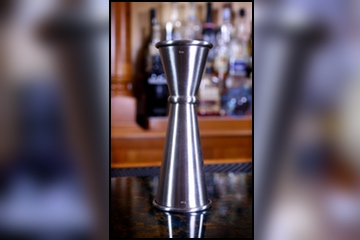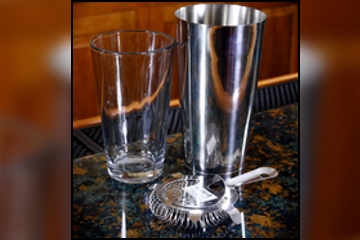Why Easy Cocktail Garnishes
A cocktail does not always need easy cocktail garnishes. Some cocktails are best left without a garnish at all. There are great arguments for a cocktail garnish: aroma & sexiness. A cocktail with a nice garnish can be more alluring. And, the key to a great cocktail experience is the aroma.
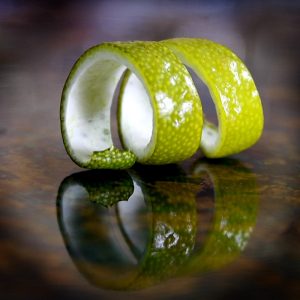
Easy Cocktail Garnish, the Citrus Twist (lime)
Garnishes provide a fancy design that showcase how much effort you put forth, but the aroma is key. Almost all garnishes provide aroma enhancements. A few garnishes bring additional flavor enhancers such as salts, sugars and zests. All garnishes bring the “I know you care about me” thoughts to the drinker.
Let’s break down some easy cocktail garnishes you can make at home. The tools you’ll probably want to have on hand include a cutting board and knife. If you have a channel knife, cool, if not, you can work around it.
Citrus Twists (moderate)
The most common citrus garnish is the classic citrus twist. While it may take some practice to get looking fantastic, this is still fits into the easy cocktail garnishes mantra. The best citrus twists come off fresh citrus fruit. Older fruit with a drier peel becomes difficult to work with and loses a lot of the appeal that makes twists fun.
- Using a knife or potato peeler, slice off the peel from around the lemon, lime, grapefruit or orange. For lemons and limes, try to cut the peel from all the way around the citrus to have enough material to work a garnish. In all cases try to get as little of the white pith as possible (its bitter).
- Place the fresh peeled rind on a cutting board, flat.
- Cut off the rough edges along the two sides of the rind so that you have a long straight piece of citrus skin.
- Twist it around a straw, swizzle stick or bar spoon (or try free hand) to build a nice twist.
Pro tip, if you want to keep the zest strong and twisted longer, take your twist and let it soak a minute in ice water. Or, skip that and stick it on the edge of your glass.
Twists form easily when warm, the warmth of your hands should help it take shape!
Citrus Zests (moderate)
Playing with citrus zest can be a rewarding experience. Especially when you get to flame them and make fire! A citrus zest is most often a slice of citrus off your fruit, cut with a sharp knife (leaving little pith on the skin/zest) or a potato peeler.
Peel/Slice off a dime sized or slightly larger piece of zest. Using fresh fruit will yield the best result with your zesting efforts. To extract the oils from our zest, we want to pinch it by folding the zest so the outside of the skin closes together on itself, causing the oils to pop from the zest.
You can warm your zest with your hands or a lighter to extract more oils. It is common for bartenders to use the flame from a match or lighter to warm the skin of their zest. Run the flame quickly over all the areas of your dime sized zest (careful not to burn yourself) and then pinch the zest.
If you pinch the zest while the flame is lit you will create a nice fire show as the oils caramelize and burn over the flame. Some folks say the caramelized oils add a slight nuance to the flavor profile, but debate is open on that–it’s really just cool to watch.
You’ll want to zest your peel above your cocktail, usually right in front of the rim of your glass. Doing this allows the oils to spray forth and land on the top of your drink and around the rim of the glass.
The oils along the glass and over the top will create a nice zesty citrus aroma and add a slight citrus kick to the sip.
Fruit Flag Garnishes (moderate)
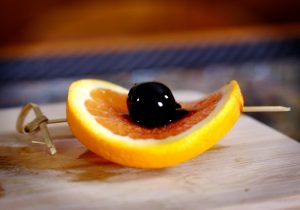
Easy Cocktail Garnish – Fruit Flag
A fruit flag is a garnish which wraps a cocktail cherry in a slide of citrus, usually an orange slice. Using a garnish pick, stick the sharp end through the left side of an orange slice, then add a Luxardo Maraschino Cherry on the stick. Lastly, poke your sharp pick end through the right side of the orange slice.
To create a fruit flag for a bourbon / whiskey cocktail we suggest using Jack Rudy Bourbon Cocktail Cherries. These big juicy cherries are both delicious, bring bourbon aroma but make for a great dessert to your cocktail.
Slapped Mint, Basil & Herbs (easy)
Spring and summer time are your chances to excel at herbal garnishes! Garnishing with herbs is simple easy. For a refreshing mojito or tiki drink you’ll find a sprig of mint makes a perfect garnish.
Don’t let your garnish go to waste, the beauty of your garnish is both visually stunning and aromatically awesome. Before you put your mint sprig into the cocktail, slap it with your hand–also called “spanking the mint” to help wake it up. Put the sprig in the palm of your hand and clap your other hand into the palm. This action will cause the mint oils to express to the surface of the herb and create a beautiful mint aroma.
You can perform the slap technique on most veiny leafy herbs such as basil. Slap your basil to give a bright herbal aroma to your favorite gin and vodka drinks.
Sugar & Salt Rim Garnishes (moderate)
The salt rim technique is well established in the margarita market. No doubt you’ve ordered a margarita at a bar, pub or restaurant and encountered a salt rim. Many establishments will use a margarita salt, which is often a blend of salts and spices. A margarita salt is typically larger / course salt that really pops off the rim and looks impressive.
Some sweeter drinks call for a sugar rim, which seems quite redundant. However, there are a few classic cocktails that rim with sugar because of the tart nature of the drink. It’s not unusual, for instance, to see a sugar rim on a lemon drop martini.
To stick salts to your cocktails (usually a sour cocktail) use a bit of the juice from your citrus around the rim. Lay your glass in a plate of salt and pull it out. Let it sit for a minute or two so it has a chance to harden.
Sugars are often stuck with simple syrup, but many cocktails use the citrus juice to stick their sugar rim. Using citrus gives you a nice sweet and tart experience on the sip.
Using salt? Be kind to your guest, only wet the outside of the glass rim with your juice. This avoids salt from sticking to the inside of the glass which often results in salty run-off into the drink. A heavily salt rimmed drink can taste like sea water by the time the imbiber is halfway finished the drink, yuck!
Olives, Onions & Cherries (easy)
By far the easiest garnish is the whole garnish, those that you just spear and top. An olive in a martini on a bamboo garnish pick is a great example. Or, onions in a gibson martini which gives the drinker both a savory onion aroma alongside a treat when the drink is finished.
Of course, the Shirley Temple with a spear of cherries is well established. However, you may find some folks using a garnish pick with a cherry in an old fashioned or other classic cocktail design. Often the pick just makes it easier to grab the cherry without having to fish it out with your hands.
When working with whole garnishes it is tradition to use one or three, but not two garnishes. A single olive in a martini is fine and classy, you’ll also see the three olive tradition. The same rule goes for onions and often cherries as well.
The tradition says the three garnishes stood for peace, love and harmony. If your guest wants additional garnishes, put them on a separate pick and place them on the side, not in the cocktail.
Bitter Dots & Foams
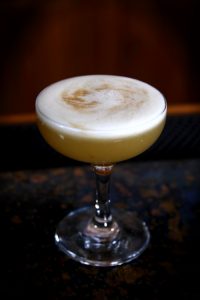
Foam and bitters on an Amaretto Sour
Egg white foam can be a garnish! You can also pull off a shaken drink with canned pineapple juice (e.g. Dole) to get a nice foamy head. The foam of pineapple juice will not last as long as egg white thanks to the protein makeup of your egg white.
You can also float bitters on top of your cocktail for additional aromatic excellence. Combining the techniques together gives you a beautiful presentation. You can easily drop a few dashes of bitters on top of an egg white foam to create a pretty appearance while also bringing that aroma to the nose.
When you’ve finished your cocktail and the foam is sitting nicely, dash a few drops of bitters (easier if you have an eye dropper on your bitters). If you want extra credit and have some artistic talent, you can use a garnish pick or other pointy device to draw with bitters. Stick your pick into the foam around the bigger dashes and drag them through the foam to draw pretty decorations like hearts and swirls!
Watch Lesson 01: Understanding Sugar & Simple Syrup In Cocktails.
Watch Lesson 02: Sours, Sour Mix, and Acidity in Cocktails.
Watch Lesson 03: What are cocktail bitters?
Watch Lesson 04: Mixed Drinks, Highballs, and Cocktails Oh My!
Watch Lesson 05: Understanding the 2:1:1 Cocktail Formula for Sours











